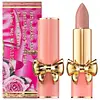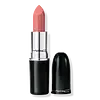What's inside
What's inside
 Key Ingredients
Key Ingredients

 Benefits
Benefits

 Concerns
Concerns

 Ingredients Side-by-side
Ingredients Side-by-side

Polybutene
Caprylic/Capric Triglyceride
MaskingPolyethylene
AbrasiveMicrocrystalline Wax
Emulsion StabilisingDicalcium Phosphate
AbrasiveStearalkonium Hectorite
Gel FormingPropylene Carbonate
SolventCocoyl Hydrolyzed Collagen
CleansingPassiflora Edulis Seed Oil
EmollientPentaerythrityl Tetra-Di-T-Butyl Hydroxyhydrocinnamate
AntioxidantMica
Cosmetic ColorantTocopherol
AntioxidantTitanium Dioxide
Cosmetic ColorantIron Oxides
CI 15850
Cosmetic ColorantCI 42090
Cosmetic ColorantCI 45410
Cosmetic ColorantCI 19140
Cosmetic ColorantPolybutene, Caprylic/Capric Triglyceride, Polyethylene, Microcrystalline Wax, Dicalcium Phosphate, Stearalkonium Hectorite, Propylene Carbonate, Cocoyl Hydrolyzed Collagen, Passiflora Edulis Seed Oil, Pentaerythrityl Tetra-Di-T-Butyl Hydroxyhydrocinnamate, Mica, Tocopherol, Titanium Dioxide, Iron Oxides, CI 15850, CI 42090, CI 45410, CI 19140
Diisostearyl Malate
EmollientCaprylic/Capric Triglyceride
MaskingRicinus Communis Seed Oil
MaskingHydrogenated Polydecene
EmollientBis-Diglyceryl Polyacyladipate-2
EmollientPolyethylene
AbrasiveTrioctyldodecyl Citrate
EmollientPolybutene
Silica
AbrasiveOzokerite
Emulsion StabilisingEuphorbia Cerifera Wax
Octyldodecanol
EmollientCalcium Aluminum Borosilicate
Tocopheryl Acetate
AntioxidantSodium Hyaluronate
HumectantSqualane
EmollientButyrospermum Parkii Butter
Skin ConditioningCocos Nucifera Oil
MaskingGlycine Soja Seed Extract
Skin ConditioningHordeum Vulgare Extract
EmollientOlea Europaea Fruit Oil
MaskingRubus Idaeus Seed Oil
EmollientSimmondsia Chinensis Seed Oil
EmollientTriticum Vulgare Germ Extract
Skin ConditioningC12-15 Alkyl Benzoate
AntimicrobialCeramide Ng
Skin ConditioningTribehenin
EmollientPalmitoyl Hexapeptide-12
Skin ConditioningTitanium/Titanium Dioxide
Cosmetic ColorantAlumina
AbrasiveSynthetic Fluorphlogopite
Aluminum Calcium Sodium Silicate
Calcium Sodium Borosilicate
Tin Oxide
AbrasivePEG-10 Phytosterol
EmulsifyingLinoleic Acid
CleansingEthylhexyl Hydroxystearate
EmollientPhytosteryl Isostearate
Skin ConditioningHydrogenated Castor Oil
EmollientVanillin
MaskingTetrahexyldecyl Ascorbate
AntioxidantPhenoxyethanol
PreservativeMica
Cosmetic ColorantCI 77891
Cosmetic ColorantCI 77491
Cosmetic ColorantCI 77492
Cosmetic ColorantCI 77499
Cosmetic ColorantCI 77163
Cosmetic ColorantCI 77400
Cosmetic ColorantCI 42090
Cosmetic ColorantCI 75470
Cosmetic ColorantCI 15850
Cosmetic ColorantCI 45380
Cosmetic ColorantCI 45410
Cosmetic ColorantCI 73360
Cosmetic ColorantCI 17200
Cosmetic ColorantCI 19140
Cosmetic ColorantCI 15985
Cosmetic ColorantDiisostearyl Malate, Caprylic/Capric Triglyceride, Ricinus Communis Seed Oil, Hydrogenated Polydecene, Bis-Diglyceryl Polyacyladipate-2, Polyethylene, Trioctyldodecyl Citrate, Polybutene, Silica, Ozokerite, Euphorbia Cerifera Wax, Octyldodecanol, Calcium Aluminum Borosilicate, Tocopheryl Acetate, Sodium Hyaluronate, Squalane, Butyrospermum Parkii Butter, Cocos Nucifera Oil, Glycine Soja Seed Extract, Hordeum Vulgare Extract, Olea Europaea Fruit Oil, Rubus Idaeus Seed Oil, Simmondsia Chinensis Seed Oil, Triticum Vulgare Germ Extract, C12-15 Alkyl Benzoate, Ceramide Ng, Tribehenin, Palmitoyl Hexapeptide-12, Titanium/Titanium Dioxide, Alumina, Synthetic Fluorphlogopite, Aluminum Calcium Sodium Silicate, Calcium Sodium Borosilicate, Tin Oxide, PEG-10 Phytosterol, Linoleic Acid, Ethylhexyl Hydroxystearate, Phytosteryl Isostearate, Hydrogenated Castor Oil, Vanillin, Tetrahexyldecyl Ascorbate, Phenoxyethanol, Mica, CI 77891, CI 77491, CI 77492, CI 77499, CI 77163, CI 77400, CI 42090, CI 75470, CI 15850, CI 45380, CI 45410, CI 73360, CI 17200, CI 19140, CI 15985
 Reviews
Reviews

Ingredients Explained
These ingredients are found in both products.
Ingredients higher up in an ingredient list are typically present in a larger amount.
This ingredient is an emollient, solvent, and texture enhancer. It is considered a skin-softener by helping the skin prevent moisture loss.
It helps thicken a product's formula and makes it easier to spread by dissolving clumping compounds.
Caprylic Triglyceride is made by combining glycerin with coconut oil, forming a clear liquid.
While there is an assumption Caprylic Triglyceride can clog pores due to it being derived from coconut oil, there is no research supporting this.
Learn more about Caprylic/Capric TriglycerideCi 15850 is the pigment color red. It is an azo dye and created synthetically.
Azo dyes need to be thoroughly purified before use. This allows them to be more stable and longer-lasting.
This ingredient is common in foundations, lipsticks, and blushes. This color is described as brown/orangey red.
It has many secondary names such as Red 6 and Red 7. According to a manufacturer, Red 6 usually contains aluminum.
Learn more about CI 15850CI 19140 is also known as Tartrazine. Tartrazine is a synthetic dye used in cosmetics, foods, and medicine to add a yellow color.
Tartrazine is created from petroleum and is water-soluble.
Some people may experience allergies from this dye, especially asthmatics and those with an aspirin intolerance.
Learn more about CI 19140Ci 42090 is a synthetic dye created from petroleum. It is used to give a bright blue color to cosmetics, medicine, and food.
CI 45410 is a synthetic red-pigment and dye.
It often goes by both Red 28 or Red 27; manufacturers label both ingredients as CI 45410.
This dye is commonly found in makeup because it imparts a vivid color. Some types of this dye change color based on pH level and interaction with moisture:
Your skin has a natural pH of around 4.5 - 5.5.
According to the FDA, CI 45410 is not permitted for use in eye products.
Red 27 is a flourescein dye and commonly used as a fluorescent tracer in medicine.
Learn more about CI 45410Mica is a naturally occurring mineral used to add shimmer and color in cosmetics. It can also help improve the texture of a product or give it an opaque, white/silver color.
Serecite is the name for very fine but ragged grains of mica.
This ingredient is often coated with metal oxides like titanium dioxide. Trace amounts of heavy metals may be found in mica, but these metals are not harmful in our personal products.
Mica has been used since prehistoric times throughout the world. Ancient Egyptian, Indian, Greek, Roman, Aztec, and Chinese civilizations have used mica.
Learn more about MicaPolybutene is used to help control the viscosity of a product. This just means it helps adjusts the texture.
It is a polymer and does not get absorbed into the skin due to its large size.
Studies found this ingredient did not irritate skin in concentrations below 15%.
Learn more about PolybutenePolyethylene is a synthetic ingredient that helps the skin retain moisture. It is a polymer.
It is also typically used within product formulations to help bind solid ingredients together and thicken oil-based ingredients. When added to balms and emulsions, it helps increase the melting point temperature.